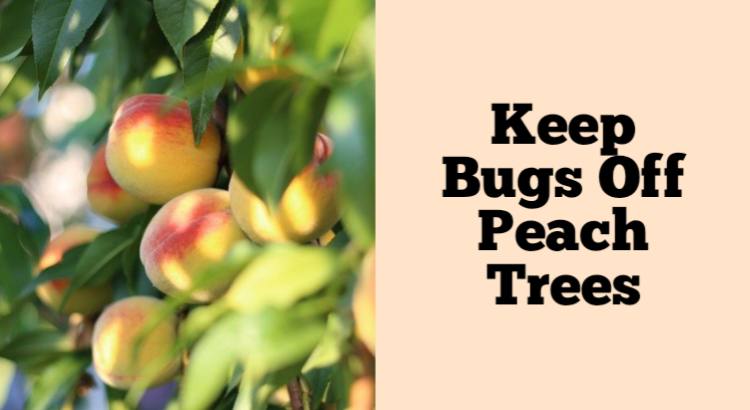There are few things worse than a peach tree infested with bugs. If you have a peach tree, you’ve probably noticed that it can become quite tedious trying to keep the fruit off of the ground.
Not only does this make your harvest look unappetizing, but it also makes it hard to try and sell at market or give away because there are plenty of ways that peaches can get ruined before they even reach their final destination.
Don’t spray when it’s super hot, cold, or raining
You may think that spraying pesticides on your peach tree is the only way to rid it of pesky bugs, but it’s important to know when and how you can do so safely.
The weather, both hot and cold, as well as wet or dry conditions can leave your peach tree exposed to damage due to over-spraying.
While some applications are okay during certain seasons, others will be harmful if they’re done in extreme conditions.
Don’t spray in the winter month. The cold temperatures will make it difficult for pesticides to work properly.
Don’t spray when there’s a chance of rain within 24 hours after application. Rainfall will wash away any residual chemicals left on your tree and may cause them to leach into groundwater or nearby streams where they could harm wildlife or humans
Be aware of what kinds of bugs are around before you spray
It’s important to know what kinds of bugs are in your area before you spray them. For example, if you’re trying to get rid of aphids, but they’re not the main problem on your tree, it will be a waste of time and money to use an insecticide that only targets aphids.
Luckily, there are several online tools that can help you identify the type of bug you’re dealing with. You’ll find a number of options for controlling these pests depending on where they’re located on your peach trees—leaves versus stems or fruit versus bark—and how severe infestations are throughout the year.
If there are other types of pests present in large numbers at certain times during the growing season (like Japanese beetles), make sure those insects also have their own control measures available before spraying anything onto your trees!
It’s also important that we mention which kinds aren’t dangerous enough to warrant pesticides: ladybugs eat aphids among other things so spraying pesticides won’t hurt them unless they’re directly applied; bees pollinate flowers while collecting pollen so spraying pesticides won’t affect their ability to do this either.
Spray in the morning for the most effectiveness
If possible, spray in the morning. The chemicals will have time to dry before nightfall, which is when bugs usually seek out their next meal.
Spreading pesticides at night can also damage tree leaves and attract insects that were hiding during the day.
Spray at least once every three weeks (preferably more often). Your peach tree will be busy producing new fruits and flowers; pests love these tender parts of the plant and can quickly multiply into an infestation if left unchecked. Be sure to apply insecticide as soon as you see signs that insects have attacked your tree—if you wait too long, they’ll simply feed on all that juicy goodness while they’re waiting!
Always spray when you see signs of infestation
Spray your peach tree as soon as you see signs of infestation. The more bugs you keep off the tree, the healthier your fruit will be and less likely to sustain damage.
If you’re looking for an all-in-one solution, look for products that have both an insecticide and a fungicide.
Most gardeners believe that insecticides are more effective at killing bugs and fungicides are more effective at killing fungus.
When used together, they can help you get rid of your peach tree’s pests faster than using either one individually.
If your peach tree has a serious pest problem, it may be worthwhile to buy a treatment with both types of chemicals in it.
Spraying on peaches is a balancing act.
You can spray your tree with insecticide to keep bugs off it, but you have to be careful. Spraying at the wrong time or in the wrong conditions can damage your peach trees and make them less productive.
Dormant oil sprays, sprayed in winter or early spring, help control scale insects and mites.
Dormant oils are horticultural oils that are not absorbed by the tree but coat the bark surface. They suffocate any insect eggs or larvae still present on the trees.
Once applied, this coating remains active for up to one year and should be reapplied if more than 60 percent of the oil has been washed off by rain during this time.
When applying dormant oil products it is important to fully cover all exposed branches with leaves on them at least once every 2 years during a growing season when temperatures remain above freezing (32°F).
Protecting peach trees from bugs is an important part of caring for them.
Keeping bugs off peach trees is an important part of caring for them. It helps keep the trees healthy and productive, beautiful, pest free, safe to eat and safe for the environment.
Conclusion
Spraying on peaches is a balancing act. You can get the best results by being aware of what kinds of bugs are around before you spray, spraying in the morning for the most effectiveness, leaving time for spraying and reapplying after rain, always spraying when you see signs of infestation and using solutions with a mix of insecticides and fungicides.

